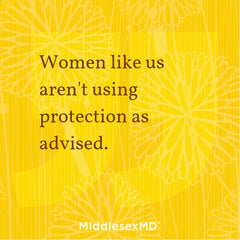Use Protection
Olympia Dukakis’ wonderful line in the hit movie, “Moonstruck”: “It ain't over till it's over!” Which is to say... pregnancy is still a possibility until you have had your ovaries removed or you have been free of both periods and spotting for an entire year.

But where STIs are concerned, our vigil is never over. As long as we are sexually active, the possibility of a Sexually Transmitted Infection (STI) finding its way to us exists. As we age and our vulvovaginal tissues lose circulation and circulating hormones, we are more vulnerable than ever to STIs.
And women like us aren’t using protection as advised. A University of Chicago study of single women aged 58 to 93 found that nearly 60 percent didn't use a condom the last time they had sex. Results from an Ohio University study were even more alarming: 35 percent of HIV-infected women over 50 and 27 percent of HIV-infected men of that age sometimes have sex without using condoms.
We're old enough to be smarter than that. We certainly have better resources. So let's be too clever to have uninformed, unprotected sex. Right?
How To
The venerable condom is still the best mechanism for safe sex, both for intercourse, for performing oral sex on a man, or when sharing sex toys (changing condoms as the toy changes partners).
Don't be shy if you haven't used a condom before. Many of us in our generation haven't—because we were in long-term relationships, used other forms of birth control, or both. Here are the basics:
- Check the expiration date on the package, and don't use a condom that seems brittle or old. Open the package along an edge so you don't damage the condom.
- Take a look to see which way the condom will roll down, and position it that way on the penis (if your partner is uncircumcised, pull back the foreskin).
- Pinch the tip of the condom so you'll leave a half-inch space for semen, and unroll the condom over the penis with your other hand, smoothing out air bubbles.
- After intercourse, have your partner pull out before the penis softens. Hold the condom at the base to prevent spilling.
For oral sex on a woman, a rubber or plastic dam (or a cut-open plastic bag) will prevent saliva and other fluids from entering the vagina.
Please remember that none of these devices can completely protect you and your partner. Our colleagues at NAMS (The North American Menopause Society) recommend that, for "safer sex," women choose partners wisely and discuss sexual histories. Insist on a latex condom for genital, oral, and anal sex, unless you're in a longstanding, mutually monogamous relationship. If you're at risk, have an annual exam and test for STIs and make sure your Hepatitis B vaccine is up to date. And, finally, if you have a confirmed STI diagnosis, urge your partner to be examined and treated.
Talking about safe sex is part of any adult sexual relationship. You can ask your regular doctor for testing, or seek out testing at a local clinic (find a clinic near you).
